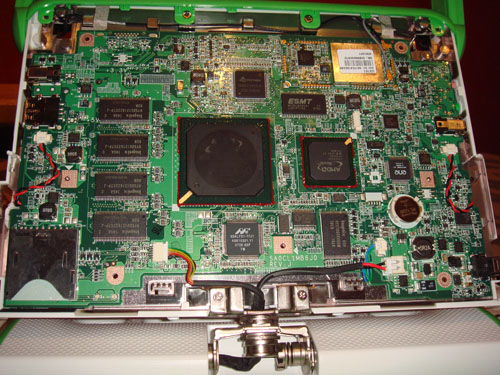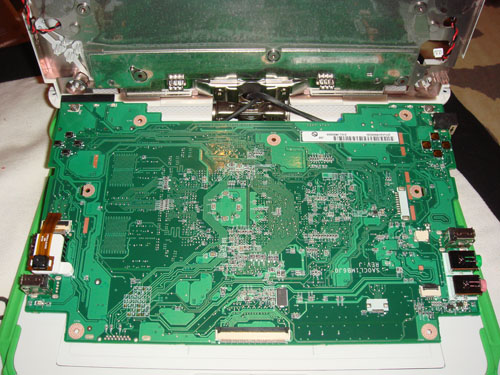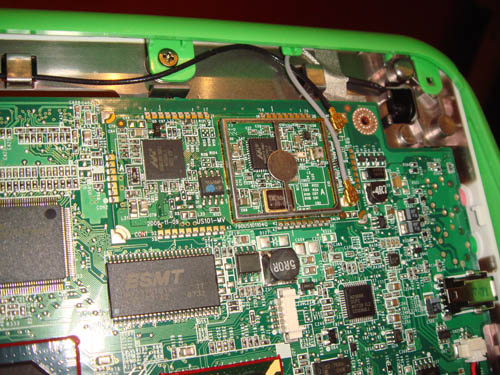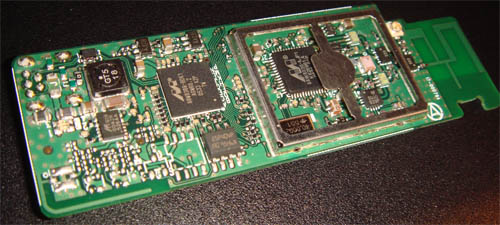I got an OLPC XO-1 a few days ago in the mail as part of the give one, get one program. Hopefully some child out there is enjoying their new laptop–there’s a certain amount of opacity in the process so I have no idea even if this laptop went to some needy far-flung village in a developing nation, as most of the propaganda would have you believe. I don’t mean to be too critical; I recognize that proper allocation of charitable resources is one of the most difficult tasks anyone can attempt, but a donation the magnitude of the laptop, even if it is only $200, is big money in the most needy countries. I somehow hesitate to think if I shouldn’t have just given a check to UNICEF instead to provide medicine to newborns. Then again, as long as one laptop is being delivered to somewhere that’s needy, I’m not doing bad compared to some other charities, where often more than half the donation is retained to cover management fees and fundraising costs. I also got a laptop out of this…so for whatever reason, Negroponte’s logic was successful in convincing me.
Well, the point of this blog isn’t to discuss the merits of charities. We like hardware, and the OLPC XO-1 is an interesting piece of hardware. There are plenty of teardowns for the OLPC XO-1 (including one on the OLPC wiki itself), so I won’t repeat the tedium of what screw comes out of where and just cut to what I thought were interesting highlights.
If I were to make one general comment about the OLPC XO-1, it’s that its mechanical design is brilliant. It’s a fairly clean-sheet redesign of traditional notebook PC mechanics around the goal of survivability, serviceability, and robustness (then again, I’ve never taken apart any of the ruggedized notebooks out there). When closed up for “travel”, all the ports are covered, and the cooling system is extremely simple so it should survive in dusty and dirty environments. Significantly, the port coverings aren’t done with rubberized end caps that you can lose or forget to put on–they are done using the wifi antennae, and the basic design causes the user to swivel them back to cover the ports when they are packing up the laptop to go. That’s thoughtful design.
The OLPC is one of the first devices to use the Li-Fe-P battery chemistry. My understanding is that it’s safer than normal Lithium Ions (and those who have been reading the chumby fora are aware of my liability and safety concerns around putting a Lithium Ion battery into any device), but it has a lower capacity.
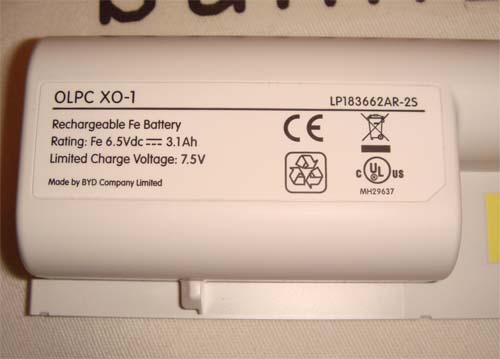
Unlike most other laptops, the OLPC is easy to take apart and service–something important for a device you are sending to a remote region of the world. The LCD, which is shock mounted, was clearly designed to be easy to replace if it was broken–a few screws to remove, some panels to slide off, and you’re done. This is unlike my T60p, where even the trained tech who did the warranty repair on it couldn’t quite put humpty dumpty back together again.
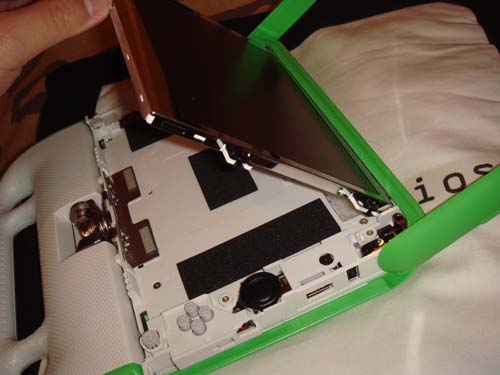
The display is made by Chilin (which is related to Chi Mei, one of the major LCD glass manufacturers–the current chumby’s glass is made by them as well). I had the fortune of meeting Scott Song from Chilin at China FOO, and he was telling me some of the interesting yet lesser-known features about the LCD. In addition to the celebrated dual-mode monochrome/color transreflective layer stack used by the panel, it also features a removeable backlight LED bar. Aside from mechanical abuse, the most common failure mode for an LCD is the backlight burning out. Most LED backlights are rated for only about 10,000 hours–if that–and it’s expensive to trash a whole LCD for the failure of a fifty cent component. Therefore, the backlight bar was designed to be easily replaced.
I gave it a whirl on the OLPC, and it certainly lived up to its expectations. Usually, to get to the backlight bar, you have to risk destroying the LCD panel, but in this case, two screws was all it took.

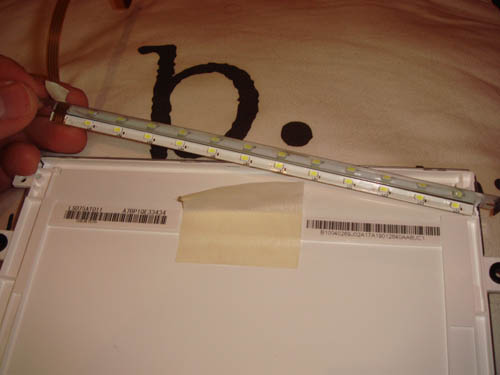
I decided to fire up the backlight outside the display, and let me tell you, that sucka is bright.
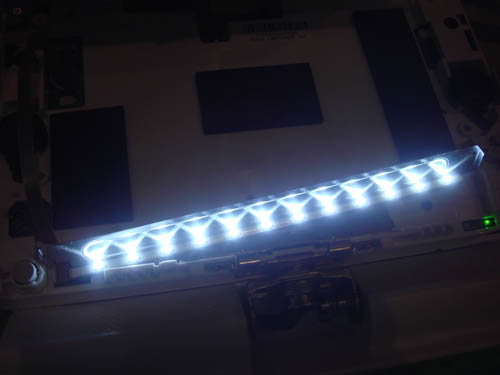
Note that the photo above wasn’t taken in the dark–it’s just that the camera shutter had to tighten up so much so that the background looked dark. If I were in the third world, I probably would say screw the laptop, I’m taking the backlight bar out and lighting my home with it!
Here again is a close-up of the pixel array used by the transreflective display (click on the image for a much larger version).
One very slick thing about the OLPC software is that I can hit a button on the lower left hand corner and it will rotate the display rendering by 90 degrees each press of the button. This allows me to easily fold the display back and use it as a sunlight-readable eBook device.
Thanks in part to the low power of the Geode CPU, the design mounts the motherboard against the LCD, unlike most laptops where the motherboard is under the keyboard. This configuration has some simplicity advantages, especially considering the flexibility required by the display unit that can be flipped 180 degrees in either direction. The heatsink for the CPU consists simply of a thin metal heat spreader, which is in close proximity to the plastic casing: no cooling holes, fins, or fans to collect dust and break (notice how the Intel Classmate PC features prominent cooling holes for its under-keyboard CPU module). It also doesn’t burn your lap up while you are using it (although the display still does get quite warm when you use it–I tucked it into my jacket once to keep me warm while running around outside in the cold).
Here’s a photo of the motherboard with the heat spreader on:
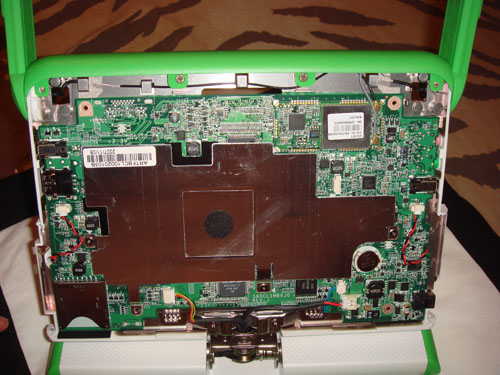
And here’s a hi-res photo of it with the heat spreader off (click on the image to access the hi-res version):
Notice how both of the large BGA chips are underfilled to provide better shock and vibration robustness. I actually have never seen an underfill like this before–it seems to be oozing out of the edges–and it also doesn’t seem to be very uniform (some spots seem to have a little underfill missing). Most underfills I’m familiar with to attempt to cover every gap and void underneath a chip (which is actually a very hard process problem); maybe this is some new kind of underfilling technique that expands a little bit upon cure to help cover voids and its robust to a few missing spots. If a reader is familiar with this type of underfill technique, I’d appreciate a link to it.
Here’s the backside of the motherboard, nice and simple (again, click for the hi-res version):
And here are some detail shots, first of the camera:
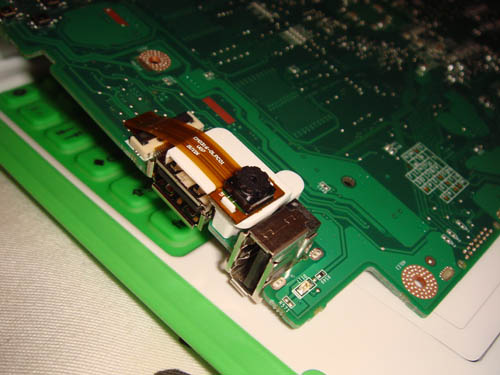
And of the wifi:
A little trivia here–this is the same chipset used inside the Microsoft Xbox360 Wireless Networking Adapter.
Presumably Microsoft doesn’t use the programmable ARM core in the Marvell 88W8388 to do something as magnanimous as bringing mesh wifi networking to the third world–probably it’s used to help implement security authentication to support their high ASPs for their closed accessories and to implement Microsoft-enhanced protocol tweaks that helps lock out competitors. Engineers make guns, they don’t tell you where to point them–that’s up to the marketing guys. Hackers take these guns apart and use the barrels and stocks as tubing and lumber to build functional art. Sometimes the art includes a bigger gun or a barrel that points backwards, and often it’s up to the media to interpret what this cryptic art means. Really, most of the time, it was done just because it’s fun to make art, but that doesn’t sell copy.
The OLPC’s wifi sensitivity is really quite excellent–the dual antennae clear of the laptop’s body do wonders for sensitivity. On the other hand, I had some trouble getting the native UI to associate the OLPC to my access point, and to get it to stay there. Overall, the software on the OLPC is clever but very “appliance-like”: there are some pre-loaded applications and it’s not immediately obvious how to add new applications using the native UI (it’s hackable from the command line but that’s not very beginner-friendly). Then again, it does include some education-oriented scripting languages that kids can use to write programs, even if it does lack a local gcc installation, and it includes the basic infrastructure for chat, video, audio, and photo sharing functionalities. If anything, I think the OLPC could play an important part in helping people keep in touch better in remote parts of the world, with some software improvements in that area (I don’t have two of these so I wasn’t able to test how easy it is to share files or connect to each other over other protocols). It also didn’t have an easy way to reconfigure the keyboard to the dvorak format that I type (I probably have to go in and hack the X configuration files via the commandline) and the keyboard is not at all comfortable for adult hands to type on–maybe I will have to plug a full-sized keyboard into the USB port to do anything extensive with the device, which sort of voids the portability aspect of the laptop. Then again, the laptop was designed for children with smaller hands, and not adults like me. Wait, I’m an adult? Crap!
Finally, some screenshots of the OLPC XO-1’s OS configuration:
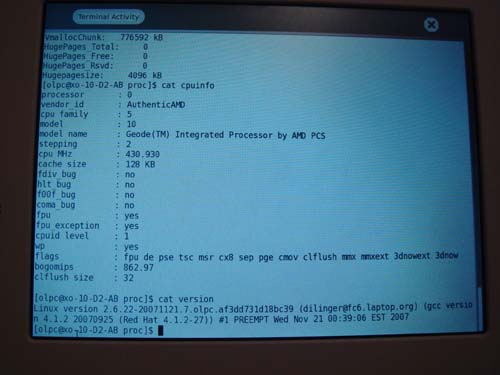
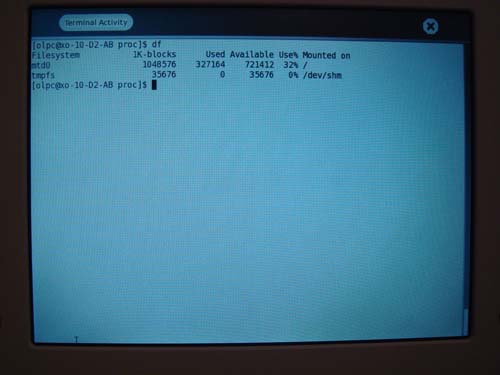
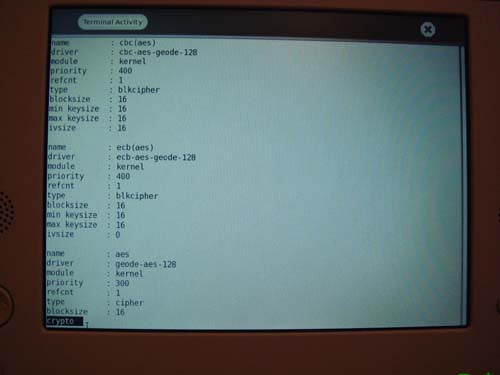
Interestingly, the OLPC ships with a hardware AES unit. Great for privacy, but presumably this is going to cause some troubles for the US government export controls when it comes to shipping the OLPC to certain third world countries on certain blacklists…I know I had to fill out parts of a somewhat thorny encryption questionnaire for the chumby lawyers as part of preparation for chumby’s sale.
